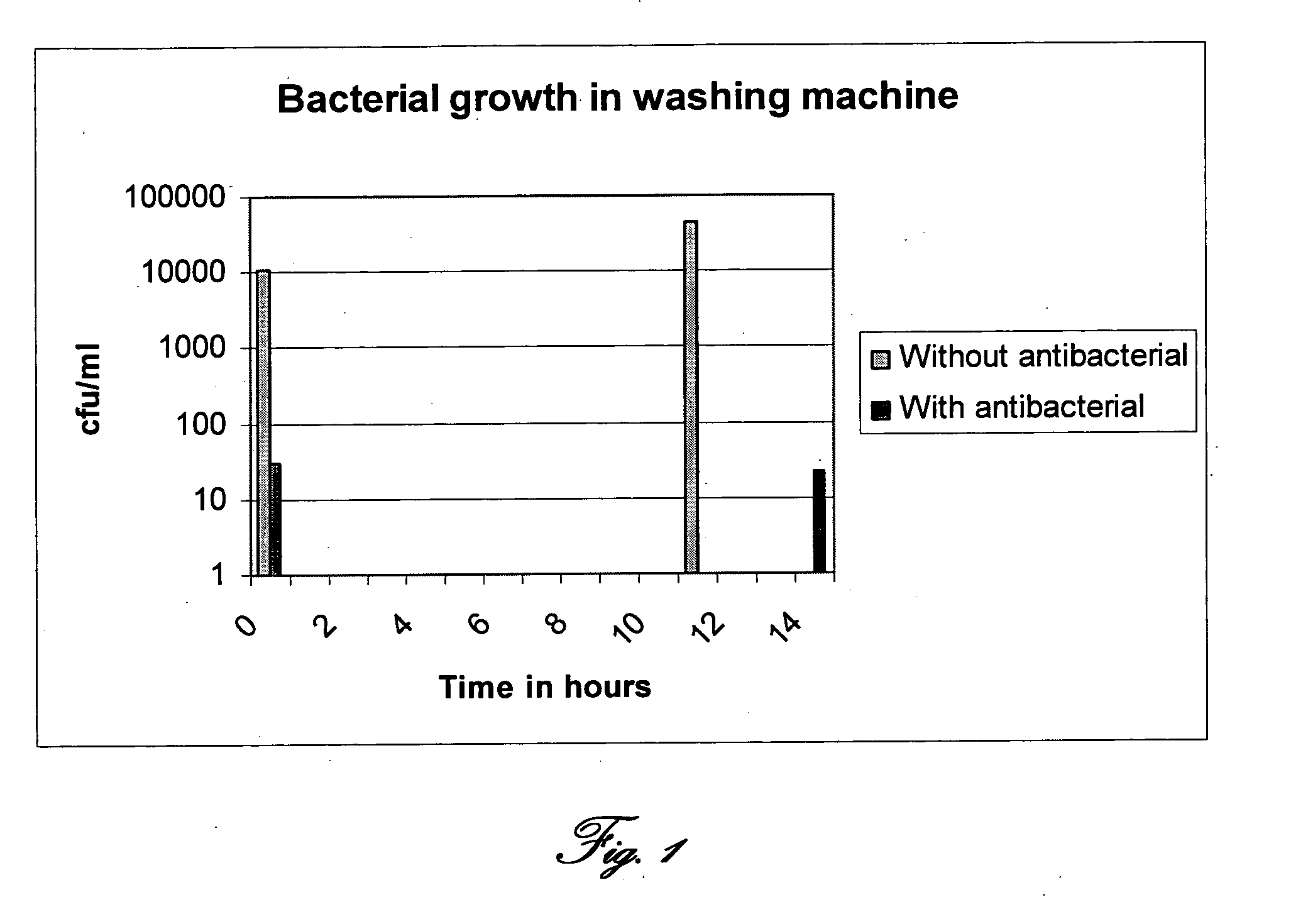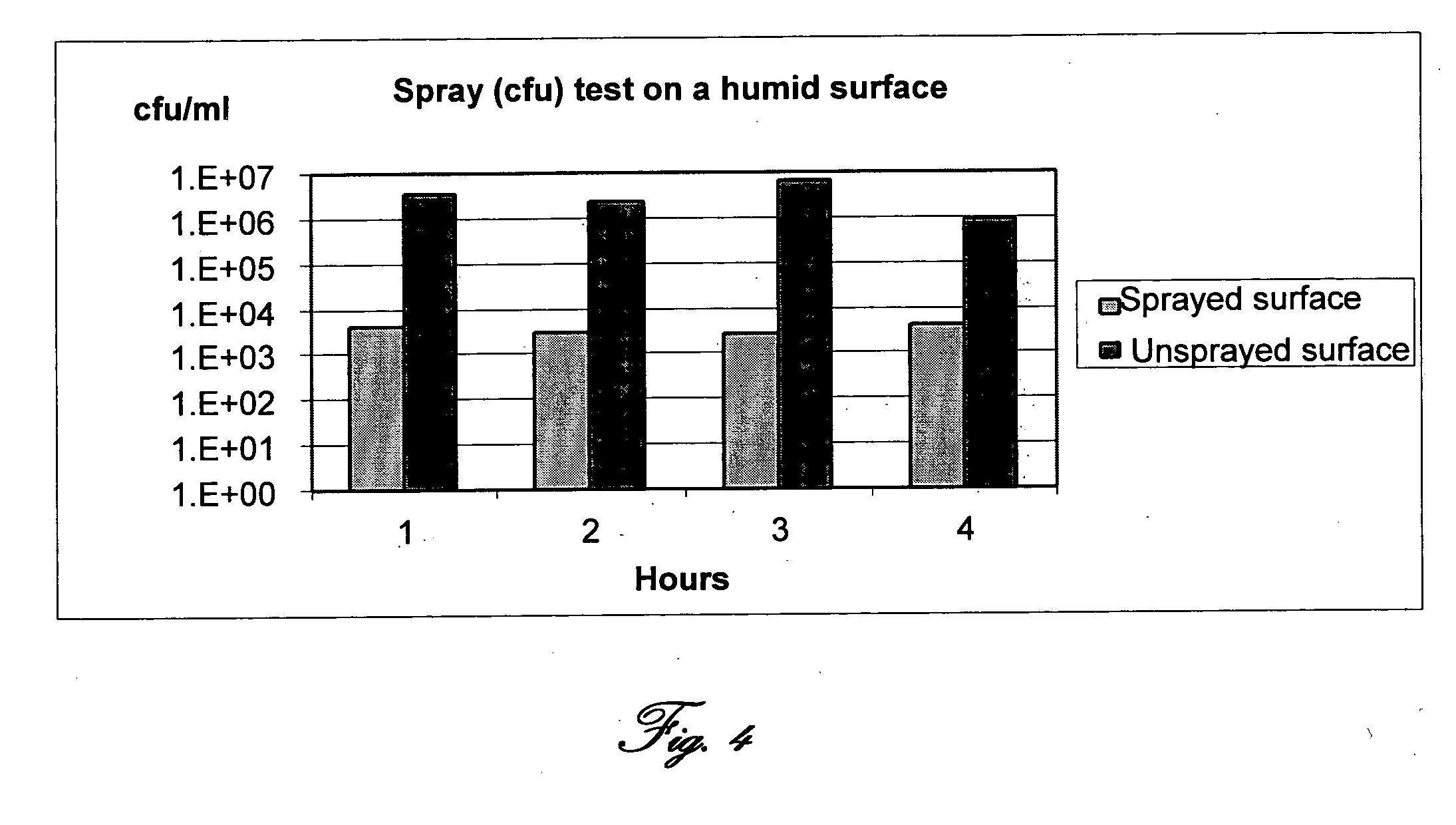Biocidic household cleansing materials
a technology of biocide and household cleaning, applied in the field of household cleaning materials, can solve the problems of biofilm formation in drinking water systems, water distribution conduits, water cooling towers for air conditioning systems, and food spoilage, and achieve the effect of effectively disrupting the ph homeostis and/or electrical balance, and efficiently preserving the ph of the ltcs' environmen
- Summary
- Abstract
- Description
- Claims
- Application Information
AI Technical Summary
Benefits of technology
Problems solved by technology
Method used
Image
Examples
example 1
[0094]Antibacterial Laundry Softener
[0095]Material and methods A regular household laundry session at home (30° C.) performed with modified softener as described above and tested against standard softener by recording bacterial growth of natural flora by placing samples of wet fabrics on agar plates, at the various intervals. Laundry was kept wet in the washing machine, at room temperature, until sampled.
[0096]Results
[0097]Reference is made to FIG. 1, illustrating the bacterial counts in fabric samples taken from regular softener treated laundry and modified softener treated laundry.
[0098]The results are presented in FIG. 1 showing 3-orders of magnitude decrease in bacterial count at time zero (right after the laundry session) and 12 hours thereafter between regular softener treated laundry and modified softener.
example 2
[0099]Antibacterial Laundry Additives
[0100]Material and Methods
[0101]Tow pieces of cotton (sample 1 & 2) were boil-washed with standard household detergents.
[0102]Following the washing stage, 50 milliliters of the spray formulations of Comp.4 above were added in the final rinse stage. Two other pieces of cotton (sample 3 & 4) were boil-washed in a standard manner and served as controls. 30 min after the wash the samples were tested for natural bacterial flora as described above. Following that test the samples were kept in open air in a very contaminated room for several days and sampled periodically.
[0103]Results
[0104]Reference in now made to FIG. 2, presenting bacterial counts (CFU) in cloth samples 0.5 and 24 hrs after boil-wash with or without antibacterial laundry additive; and to FIG. 3, presenting bacterial counts (CFU) in cloth, samples 0.5, 24, 48 hrs and 9 days after boil-wash with or without antibacterial laundry additive.
[0105]The results are summarized in the following ...
example 3
[0106]Antibcterial Spray
[0107]Material and Methods
[0108]A part of a humid surface (a marble top near the sink in a public toilet) was treated with a spray solution of Comp.1 and sampled once every hour for 4 consecutive hours, for bacterial content by swab sampling and spreading on a Petri dish.
[0109]Results
[0110]Reference in now made to FIG. 4, showing bacterial counts (CFU) in samples taken from sprayed and unsprayed marble surface.
[0111]Results in Table 2 and FIG. 4 below show a difference of 3-orders-of-magnitude in bacterial population between spray-treated and untreated marble surface.
TABLE 2Bacterial counts (CFU) in samples takenfrom sprayed and unsprayed marble surfaceTime afterSprayed surfaceUnsprayed surfacetreatment (h)(CFU)(CFU)13.9 × 1033.5 × 10623.1 × 1032.4 × 10632.7 × 1036.8 × 10643.9 × 1039.2 × 105
PUM
| Property | Measurement | Unit |
|---|---|---|
| time | aaaaa | aaaaa |
| average diameter | aaaaa | aaaaa |
| average diameter | aaaaa | aaaaa |
Abstract
Description
Claims
Application Information
 Login to View More
Login to View More - R&D
- Intellectual Property
- Life Sciences
- Materials
- Tech Scout
- Unparalleled Data Quality
- Higher Quality Content
- 60% Fewer Hallucinations
Browse by: Latest US Patents, China's latest patents, Technical Efficacy Thesaurus, Application Domain, Technology Topic, Popular Technical Reports.
© 2025 PatSnap. All rights reserved.Legal|Privacy policy|Modern Slavery Act Transparency Statement|Sitemap|About US| Contact US: help@patsnap.com



